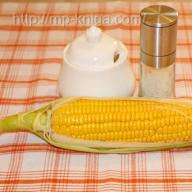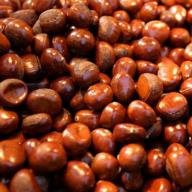Harvesting tomatoes for the winter has a huge number of cooking options. The most popular of them, oddly enough, are not particularly complex. Experienced housewives know how to pickle tomatoes in jars for the winter - simple recipes include a minimum of ingredients: vegetables, water, salt and spices.
Cold pickling without vinegar
To preserve the maximum amount of vitamins and microelements in tomatoes, they should be salted without using vinegar. No matter how diverse the recipes for this method of pickling may be, they have one thing in common: storage conditions. The snack will be suitable for consumption only if stored at low temperatures.
Red tomatoes
For cooking, we select vegetables of the same size and varieties with similar taste characteristics.
Ingredients:
- ripe tomatoes – 3 kg;
- table salt – 15 g;
- water – 0.4 l;
- garlic – 8 cloves;
- bell pepper – 1 medium;
- hot pepper – ½ pcs.;
- dill inflorescences – 5 pcs.
Preparation:
Put water on the fire. After boiling, dissolve the salt in it. Return to the stove and let it boil again. Remove from the cooking surface and cool the brine to room temperature. Place the peeled garlic and prepared sweet and hot peppers (without stems and seeds) into a blender and grind into a paste.
We fill jars disinfected in the microwave with vegetables. We alternate the layers with dressing and fill the containers with marinade. Cover the pickles with a nylon lid and put them in the refrigerator. After a couple of weeks, the snack can be placed on the table.
Green tomatoes
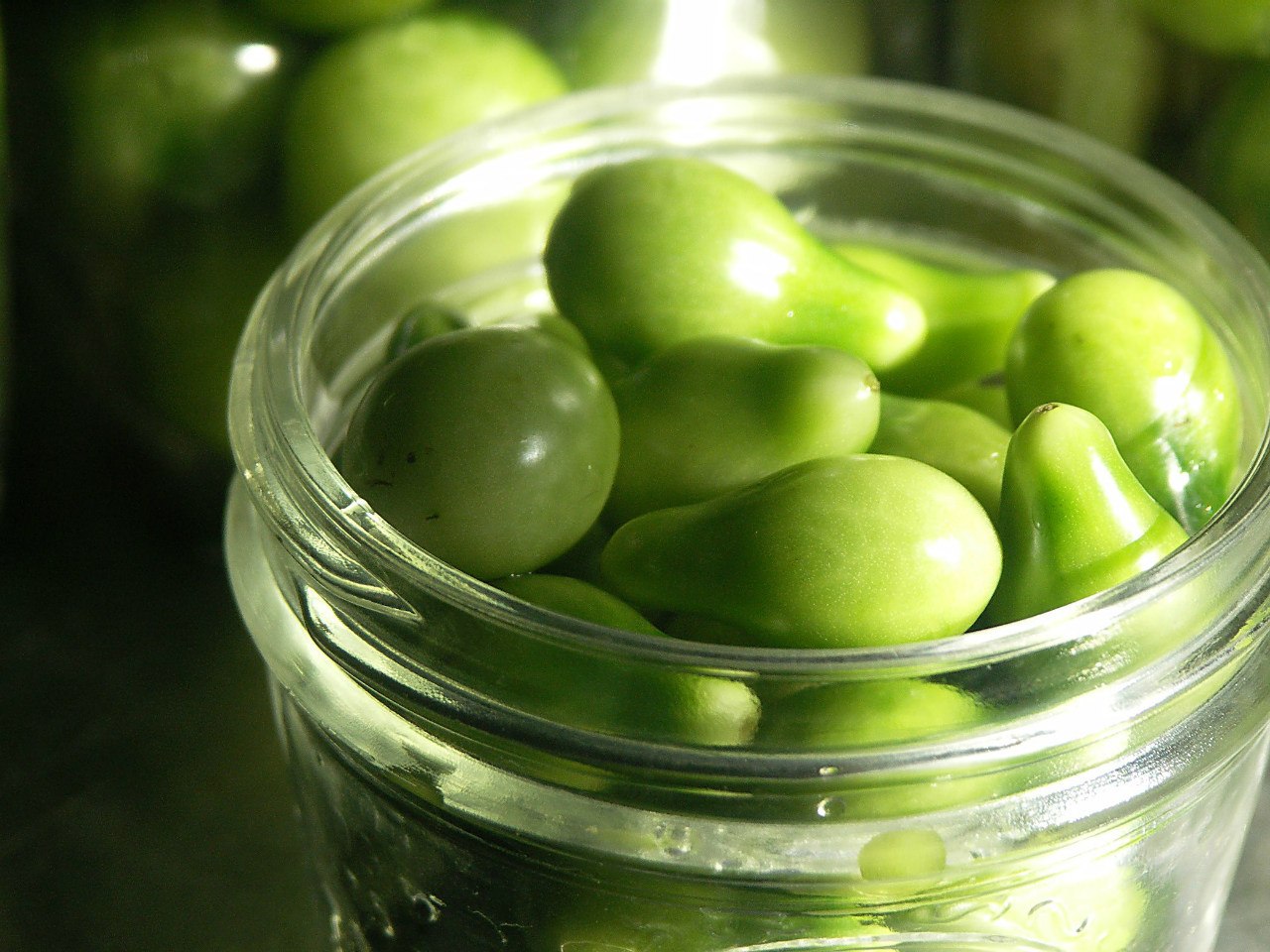 Green tomatoes that are richer in taste and denser in consistency can also be salted without vinegar.
Green tomatoes that are richer in taste and denser in consistency can also be salted without vinegar.
Ingredients:
- unripe tomatoes – 0.4 kg;
- water – 0.4 l;
- salt – 15 g;
- currants (preferably black) – 4 leaves;
- dill - a pair of inflorescences;
- garlic – 5 shares;
- horseradish – 2 medium or 1 large leaves;
- allspice – 2 peas.
Preparation:
We heat glass jars over steam. Chop the garlic cloves and horseradish leaves with a knife. Place some of the seasoning at the bottom of the container and sprinkle it on each layer of green fruit. Salt water at room temperature and fill the contents of the jars with marinade. Cover with a polyethylene lid. We place the jars in a cool place, such as a cellar. During the month, we open the container twice to allow fresh air to enter the snack. After 4 weeks, the pickles are ready for tasting.
Classic recipe for salted tomatoes per 1 liter
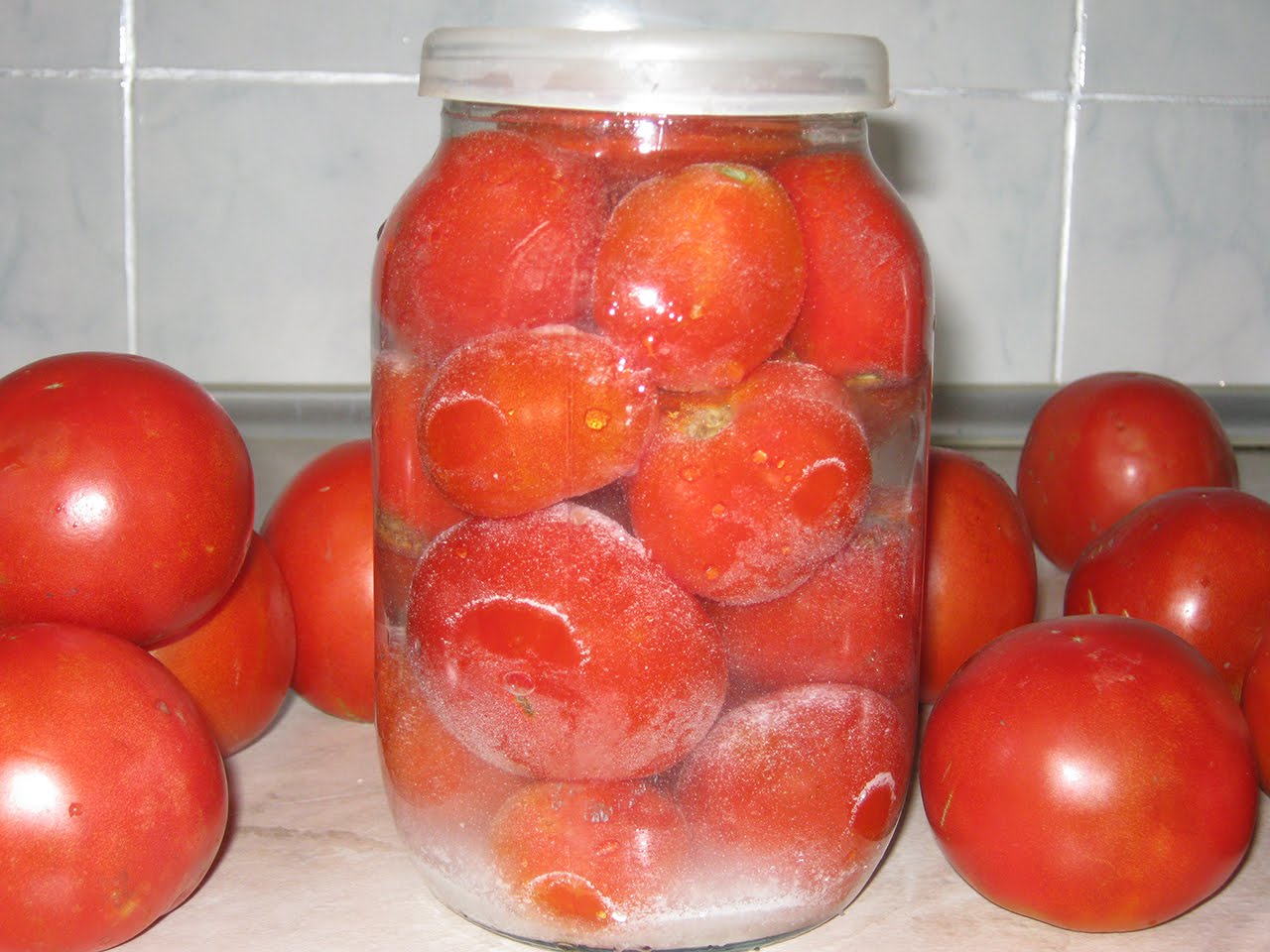 Knowing the classic version with a dosage per 1 liter of product yield, you can experiment with both the volume and the ingredients of the winter tomato snack. The main thing is to strictly observe the proportions.
Knowing the classic version with a dosage per 1 liter of product yield, you can experiment with both the volume and the ingredients of the winter tomato snack. The main thing is to strictly observe the proportions.
Ingredients:
- medium-sized tomatoes – 7-8 pcs.;
- water – 400 g;
- salt – 12 g;
- sugar – 15 g;
- acetic acid (72%) – 15 g;
- garlic – 4 cloves;
- horseradish root – 50-70 g;
- peppercorns – 4 pcs.;
- bay leaf – 2 pcs.
Preparation:
Place the washed and peeled garlic and horseradish roots, peppercorns and bay leaves into the bottom of a sterilized jar. Fill the container with vegetables, cover the top with dill umbrellas. Boil filtered water in a saucepan and pour in the tomatoes. Seal everything with a plastic lid for 20 minutes. After a third of an hour, put the liquid on the fire again, stir sugar and salt in it and let it boil. Pour the brine into a jar, carefully add a spoonful of vinegar essence on top and roll it up with a tin lid. We place the containers upside down and cover them with warmth (blanket, bedspread, terry towels, etc.) for a day. Readiness period – 3-4 weeks.
To ensure that the appetizer has a marketable appearance when served, vegetables should not be compacted when filling the jar. In tight spaces they will certainly crack. An additional precaution in this regard is to pierce the fruit near the stalk. By the way, it is better not to remove it: a treat with a twig looks more appetizing.
Hot method of pickling tomatoes with vinegar
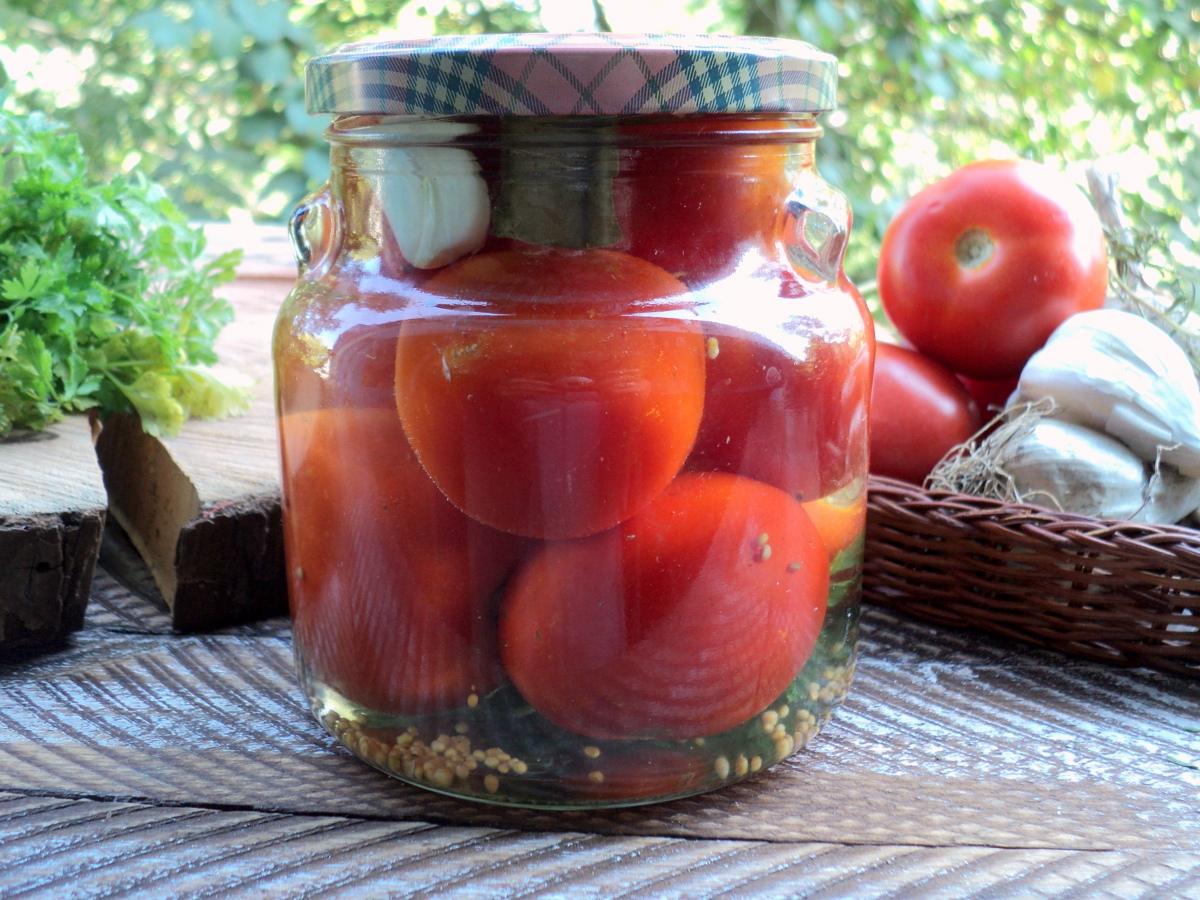 This option for preparing tomatoes using vinegar has many varieties: this is how dried and pickled vegetables, sweet, bitter and spicy, are pickled. One of the most popular and simple recipes is a version using garlic cloves, dill inflorescences and foliage from garden trees. The recipe is based on ingredients for a three-liter container.
This option for preparing tomatoes using vinegar has many varieties: this is how dried and pickled vegetables, sweet, bitter and spicy, are pickled. One of the most popular and simple recipes is a version using garlic cloves, dill inflorescences and foliage from garden trees. The recipe is based on ingredients for a three-liter container.
Ingredients:
- tomatoes – 11-16 pcs. (depending on size);
- salt – 30 g;
- sugar – 75 g;
- water – 1.2 l;
- black currant – 4 leaves;
- wild cherry - 3 leaves;
- horseradish leaves - 1 medium;
- dill inflorescences – 3 pcs.;
- garlic – 6 cloves;
- laurel – 3 leaves;
- black pepper – 6 pcs.;
- coriander – 5 pcs.;
- acetic acid (72%) – 1 tablespoon.
Preparation:
We wash vegetables, leaves and inflorescences of plants. We heat the glass in the microwave. First pour the pepper into the glass container, then the coriander, garlic cloves and bay leaf. Fill the jar with tomatoes. Pour boiling water and leave the food to warm up for half an hour. After this time, drain the marinade, add salt and dilute the required amount of sugar in it. We bring the temperature to 100 degrees again.
Add cherry, currant and horseradish leaves and dill umbrellas to the jars. Fill everything with brine and add a spoonful of vinegar on top. We close the jars with tin lids, turn them over and cover them with a blanket for 10 hours.
Salted barrel tomatoes
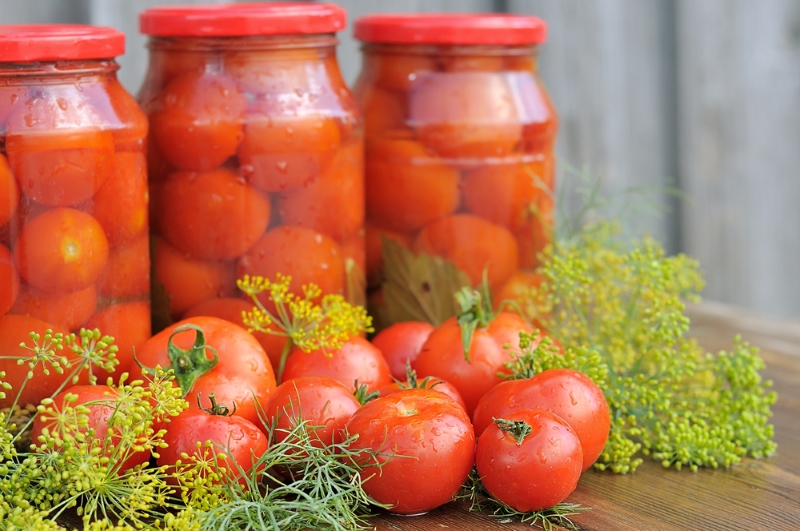 The special taste of barrel salted tomatoes can be reproduced in urban environments. For this you do not need a large oak barrel; its analogue will be a bucket made of food-grade plastic. Otherwise, everything remains the same as in the old Russian recipe.
The special taste of barrel salted tomatoes can be reproduced in urban environments. For this you do not need a large oak barrel; its analogue will be a bucket made of food-grade plastic. Otherwise, everything remains the same as in the old Russian recipe.
Ingredients:
- tomato – 2500 g;
- coarse salt – 90g;
- water – 2500 ml;
- horseradish – 5 leaves and 70-100 g of roots;
- cherry leaves – 16 pcs.;
- currant leaves – 12 pcs.;
- dill inflorescences – 4 pcs.;
- basil (greens) – 2 plants;
- mint – 7-8 leaves;
- laurel – 4 leaves;
- garlic – 4 cloves and 7 arrows;
- hot pepper – 1 pc.;
- allspice – 4 peas;
- coriander – 8 pcs.;
- mustard seeds – 10 pcs.
Preparation:
We thoroughly wash all products and clean the horseradish roots. We form an “air cushion” at the bottom: lay out half of the spices. Leaves of bushes and mint, horseradish; slices of garlic arrows cut into cubes; Umbrellas of dill and basil will preserve the presentation of the pickles.
We pierce each tomato with a wooden toothpick in the area of the stalk to speed up the fermentation process. We fill a bucket with fruits, put the remaining components of our “pillow” on top, as well as the burning pod.
To prepare the marinade, salt boiling water and add granulated sugar, bay leaf and peppercorns, mustard seeds and coriander. As soon as the brine boils, fill the tomatoes completely. The process of immersing vegetables in water must be gradual, otherwise the skin will crack. Any remaining marinade should end up in the bucket. Once the brine has seeped all the way to the bottom and covered the spices that are on top, you can begin the final stage of pickling.
Instead of a lid, we use a plate of slightly smaller diameter, on which we install the oppression. The marinade should seep out from under our press plate, which will indicate that the contents of the container are completely immersed in the brine.
Leave the snack for 24 hours at room temperature. During this time, fermentation will appear in the form of foam on the surface of the plate, and the brine in the bucket will become cloudy. After 4-5 days, the solution will become noticeably lighter, and the tomatoes will decrease in volume. This means that the fermentation process has taken place. 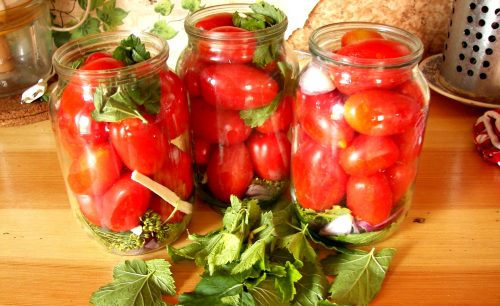
Remove the weight, remove the plate and close the bucket with a tight lid. This snack should be stored either in the refrigerator or in the cellar. The salting will be completely ready in a month and can be eaten until next autumn.
The marinade actively penetrates into the fetus during the first two weeks. Then the process slows down and finally disappears after three months. This means that the vegetables become lightly salted and ready to eat within a couple of weeks after twisting. They collect salt until about December and then retain their taste unchanged for the entire remaining shelf life.
Salting with halves
If the harvest is successful in size, the pickling process comes to a dead end: the fruits do not pass through the neck of the jar. In this case, a recipe for salting tomatoes in halves always helps out.
With sunflower oil
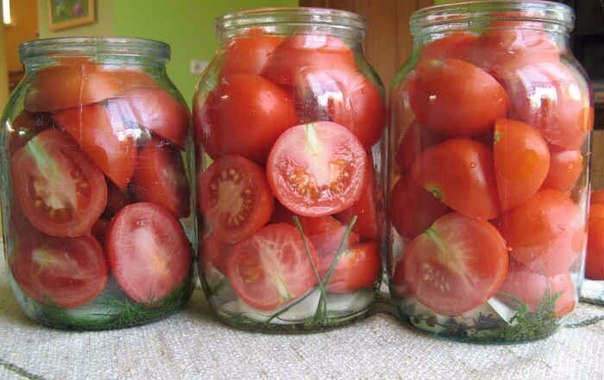 A simple and quick recipe includes, in addition to the usual ingredients, vegetable oil. It makes the snack more delicate in taste. The quantity of products is calculated for a container with a volume of 1 liter.
A simple and quick recipe includes, in addition to the usual ingredients, vegetable oil. It makes the snack more delicate in taste. The quantity of products is calculated for a container with a volume of 1 liter.
Ingredients:
- tomato – 0.7 kg;
- salt – 15 g;
- sugar – 25 g;
- garlic – 2 cloves;
- parsley - 3 sprigs;
- bay leaf – 1 pc.;
- black pepper – 2 peas;
- citric acid – 1 tsp;
- vegetable oil – 1 tbsp;
- hot pepper – 1 pc.
Preparation:
We wash the food, peel the pepper and garlic. Cut large tomatoes in half. Fill a clean container with vegetables, and place parsley and garlic cloves there. For the marinade, add bay leaves and peppercorns to boiling water, add salt and dissolve granulated sugar and citric acid. Fill the jars with the solution, leave the vegetables to soak and warm up for 30 minutes. Then drain the marinade, bring its temperature to 100 degrees on the fire a second time and pour it into the pickles. Gently place a spoonful of vegetable oil on top. Roll up with tin lids, wrap in heat for 10 hours and put in a cool place for storage.
With mustard
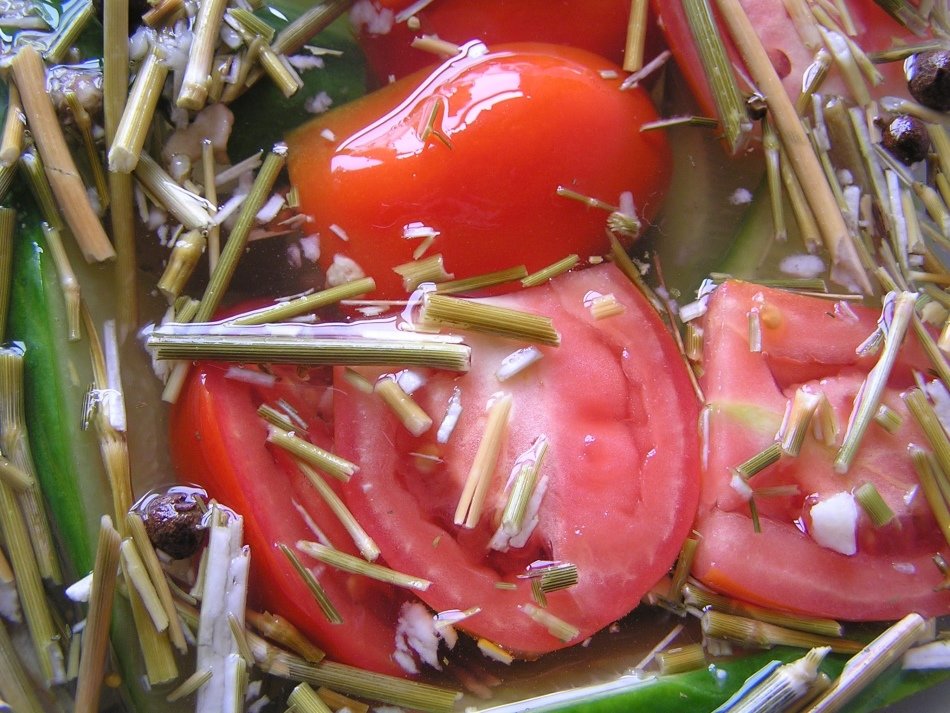 An increased number of mustard grains compared to the usual proportions can radically change the taste of a familiar product. The pickle turns out to be sweet and sour with a spicy, unique bitterness.
An increased number of mustard grains compared to the usual proportions can radically change the taste of a familiar product. The pickle turns out to be sweet and sour with a spicy, unique bitterness.
Ingredients:
- tomatoes – 750 g;
- salt – 12 g;
- sugar – 60 g;
- garlic – 3 cloves;
- mustard seeds – 20 g;
- vinegar essence – 5 g;
- allspice – 2 peas;
- dill greens – 4 sprigs;
- hot pepper – ½ pc.
Preparation:
Cut the selected and washed fruits into two halves. First of all, pour the mustard seeds and garlic into the container, then place the vegetables, pulp side down, and dill on top.
Prepare the marinade. We dilute bulk products in boiling water, then add pepper. Fill the halves with brine for half an hour. To re-boil, drain the marinade using a nylon lid with a spout and special holes. Bring the marinade to a boil over the heat and immediately pour it over the warm tomatoes.
Close the lids using a seaming machine. Turn it upside down and cover it with a blanket for half a day. After complete cooling, store at a temperature no higher than 10 degrees.
With celery
 Not the most common recipe for halves with celery surprises not only with its piquant taste, but also with its unusual appearance. To prevent the snack from turning into a mushy mass, the choice should be made on fleshy specimens with medium-thick skin. This will allow the products to retain their appetizing appearance after heat treatment.
Not the most common recipe for halves with celery surprises not only with its piquant taste, but also with its unusual appearance. To prevent the snack from turning into a mushy mass, the choice should be made on fleshy specimens with medium-thick skin. This will allow the products to retain their appetizing appearance after heat treatment.
Ingredients:
- tomatoes – 1200 g;
- green celery – 2 branches;
- black pepper – 3 peas;
- dill inflorescences – 2 pcs.;
- cilantro – 3 sprigs;
- garlic – 6 cloves;
- salt – 30 g;
- sugar – 25 g;
- citric acid – 1 tsp.
Preparation:
We blanch most of the clean, halved tomatoes and place them in a glass container, where pepper, chopped celery stalks and cilantro are already placed. Simmer the remaining vegetables over low heat for 15 minutes. Salt and dissolve sugar and citric acid. Make the dressing homogeneous using a blender. To get rid of the seeds, rub the resulting mixture through a sieve. Fill the halves with sauce in a glass jar and close with a lid.
Here you can use threaded lids or use a seaming machine. The main thing is that the contents of the container are hot.
The best salt for working with tomatoes is rock salt, “Extra” class. Iodized fine salt is definitely not recommended for pickling. Its crystals penetrate too quickly into the fruit, iodine changes the normal rate of fermentation. As a result, you can get soft, moldy fruits of indeterminate shape - if the jar simply does not explode during the first three weeks.
- For canning, you should choose fruits without flaws of approximately the same size and variety. A harvest harvested on a warm, sunny day is preferable.
- Before salting, glass containers are disinfected over steam, in the oven or in the microwave for half an hour. Tin lids are sterilized in boiling water.
- Almost all varieties of tomatoes are suitable for winter harvesting. Red, yellow, brown, unripe green fruits look great on the table whole or cut. If the vegetable is not soft enough, it can be blanched.
- The minimum products that need to be stocked up before salting, except tomatoes, are garlic, horseradish roots, dill inflorescences and, of course, sugar, salt and vinegar.
- Regardless of the composition of the marinade, the storage temperature of pickles should not rise above 10 degrees. The shelf life of this type of snack is one year under appropriate conditions.
Conclusion
The answer to the question of how to pickle tomatoes in jars for the winter is not complicated. Simple recipes and affordable products allow you to prepare fruits in the shortest possible time. The main thing is not to forget three rules.
- Dishes, vegetables and spices must be perfectly clean.
- Do not experiment with new recipes on the entire available harvest.
- Do not serve food from jars with bulging lids, foam or mold inside.
Any treat should improve the health of loved ones, please with an appetizing appearance and surprise with its variety of flavors.

